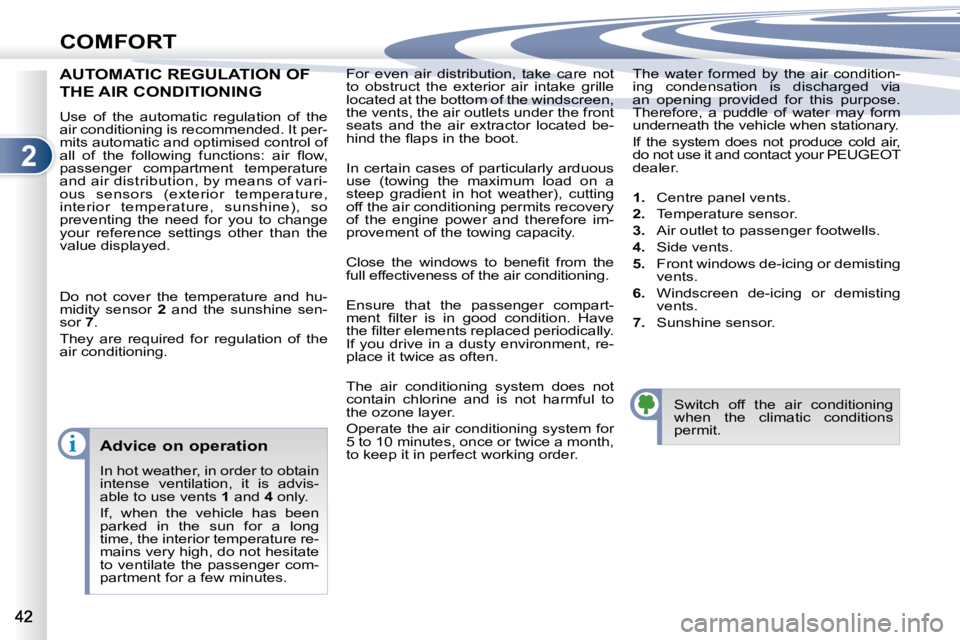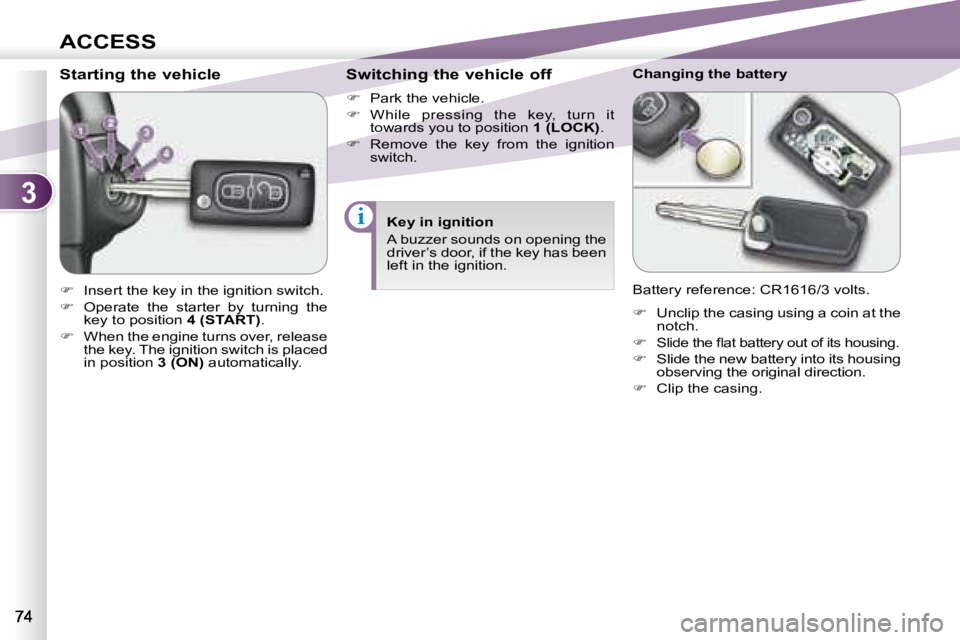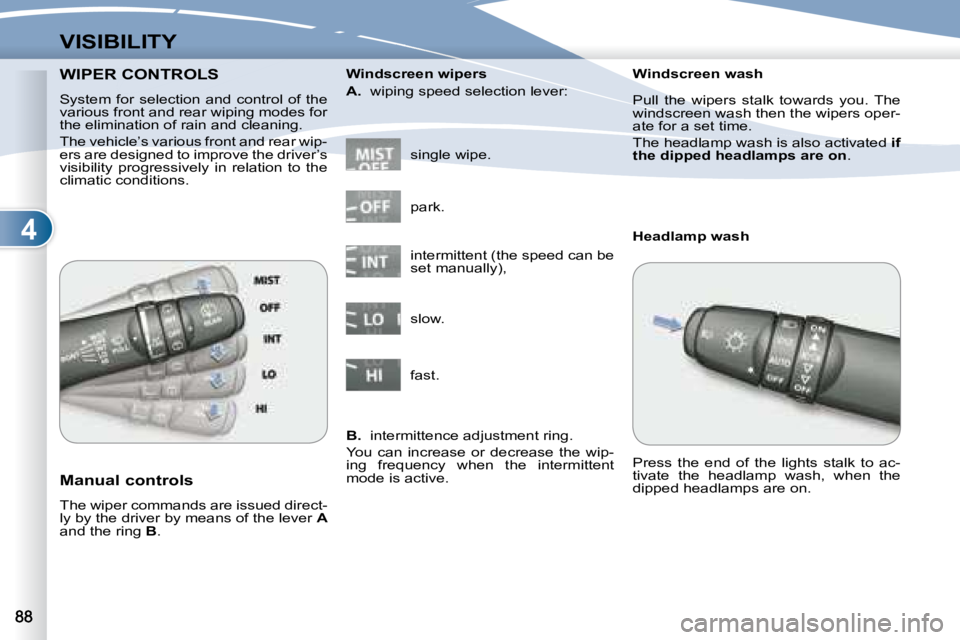2007.5 PEUGEOT 4007 tow
[x] Cancel search: towPage 17 of 221

1
CRUISE
INSTRUMENTS and CONTROLS
INSTRUMENT PANEL INDICATOR LIGHTS
Indicator lights is on Cause Observations
Left-hand
direction
indicator Flashing
with
buzzer � �T�h�i�s� �fl� �a�s�h�e�s� �w�h�e�n� �y�o�u�
press the lights stalk
down. � �I�f� �t�h�i�s� �i�n�d�i�c�a�t�o�r� �l�i�g�h�t� �fl� �a�s�h�e�s� �a�b�n�o�r�m�a�l�l�y� �q�u�i�c�k�l�y�,�
this could indicate that the electric bulb of one
of the direction indicators has blown. Change
the bulb or contact a PEUGEOT dealer.
Right-hand
direction
indicator Flashing
with
buzzer � �T�h�i�s� �fl� �a�s�h�e�s� �w�h�e�n� �y�o�u�
push the lights stalk up. � �I�f� �t�h�i�s� �i�n�d�i�c�a�t�o�r� �l�i�g�h�t� �fl� �a�s�h�e�s� �a�b�n�o�r�m�a�l�l�y� �q�u�i�c�k�l�y�,�
this could indicate that the electric bulb of one
of the direction indicators has blown. Change
the bulb or contact a PEUGEOT dealer.
Main beam
headlamps Fixed This comes on when
you pull the lights stalk
towards you. Pull the stalk to return to dipped headlamps.
Side lights Fixed This comes on when
the lights stalk is in the
"Side lights" or "Dipped
headlamps" position. � �T�u�r�n� �t�h�e� �s�t�a�l�k� �t�o� �t�h�e� �p�o�s�i�t�i�o�n� �r�e�q�u�i�r�e�d�.�
Front fog
lamps Fixed This comes on when you
use the front fog lamps. Turn the ring on the stalk forwards to switch on
the fog lamps.
Rear fog
lamps Fixed This comes on when you
use the rear fog lamps. Turn the ring on the stalk forwards to switch on
the fog lamps.
Cruise control Fixed This comes on when the
mode is active. Press the "ON/OFF" button to activate/
deactivate the mode.
Page 44 of 221

2
i
COMFORT
For even air distribution, take care not
to obstruct the exterior air intake grille
located at the bottom of the windscreen,
the vents, the air outlets under the front
seats and the air extractor located be-
�h�i�n�d� �t�h�e� �fl� �a�p�s� �i�n� �t�h�e� �b�o�o�t�.�
� �I�n� �c�e�r�t�a�i�n� �c�a�s�e�s� �o�f� �p�a�r�t�i�c�u�l�a�r�l�y� �a�r�d�u�o�u�s�
use (towing the maximum load on a
�s�t�e�e�p� �g�r�a�d�i�e�n�t� �i�n� �h�o�t� �w�e�a�t�h�e�r�)�,� �c�u�t�t�i�n�g�
�o�f�f� �t�h�e� �a�i�r� �c�o�n�d�i�t�i�o�n�i�n�g� �p�e�r�m�i�t�s� �r�e�c�o�v�e�r�y�
�o�f� �t�h�e� �e�n�g�i�n�e� �p�o�w�e�r� �a�n�d� �t�h�e�r�e�f�o�r�e� �i�m�-
�p�r�o�v�e�m�e�n�t� �o�f� �t�h�e� �t�o�w�i�n�g� �c�a�p�a�c�i�t�y�.�
� �C�l�o�s�e� �t�h�e� �w�i�n�d�o�w�s� �t�o� �b�e�n�e�fi� �t� �f�r�o�m� �t�h�e�
�f�u�l�l� �e�f�f�e�c�t�i�v�e�n�e�s�s� �o�f� �t�h�e� �a�i�r� �c�o�n�d�i�t�i�o�n�i�n�g�.�
� �E�n�s�u�r�e� �t�h�a�t� �t�h�e� �p�a�s�s�e�n�g�e�r� �c�o�m�p�a�r�t�-
�m�e�n�t� �fi� �l�t�e�r� �i�s� �i�n� �g�o�o�d� �c�o�n�d�i�t�i�o�n�.� �H�a�v�e�
�t�h�e� �fi� �l�t�e�r� �e�l�e�m�e�n�t�s� �r�e�p�l�a�c�e�d� �p�e�r�i�o�d�i�c�a�l�l�y�.�
�I�f� �y�o�u� �d�r�i�v�e� �i�n� �a� �d�u�s�t�y� �e�n�v�i�r�o�n�m�e�n�t�,� �r�e�-
�p�l�a�c�e� �i�t� �t�w�i�c�e� �a�s� �o�f�t�e�n�.�
� �T�h�e� �a�i�r� �c�o�n�d�i�t�i�o�n�i�n�g� �s�y�s�t�e�m� �d�o�e�s� �n�o�t�
contain chlorine and is not harmful to
�t�h�e� �o�z�o�n�e� �l�a�y�e�r�.�
� �O�p�e�r�a�t�e� �t�h�e� �a�i�r� �c�o�n�d�i�t�i�o�n�i�n�g� �s�y�s�t�e�m� �f�o�r�
5 to 10 minutes, once or twice a month,
�t�o� �k�e�e�p� �i�t� �i�n� �p�e�r�f�e�c�t� �w�o�r�k�i�n�g� �o�r�d�e�r�.� � �T�h�e� �w�a�t�e�r� �f�o�r�m�e�d� �b�y� �t�h�e� �a�i�r� �c�o�n�d�i�t�i�o�n�-
ing condensation is discharged via
�a�n� �o�p�e�n�i�n�g� �p�r�o�v�i�d�e�d� �f�o�r� �t�h�i�s� �p�u�r�p�o�s�e�.�
�T�h�e�r�e�f�o�r�e�,� �a� �p�u�d�d�l�e� �o�f� �w�a�t�e�r� �m�a�y� �f�o�r�m�
�u�n�d�e�r�n�e�a�t�h� �t�h�e� �v�e�h�i�c�l�e� �w�h�e�n� �s�t�a�t�i�o�n�a�r�y�.�
� �I�f� �t�h�e� �s�y�s�t�e�m� �d�o�e�s� �n�o�t� �p�r�o�d�u�c�e� �c�o�l�d� �a�i�r�,�
�d�o� �n�o�t� �u�s�e� �i�t� �a�n�d� �c�o�n�t�a�c�t� �y�o�u�r� �P�E�U�G�E�O�T�
�d�e�a�l�e�r�.�
1. � � �C�e�n�t�r�e� �p�a�n�e�l� �v�e�n�t�s�.�
2. � � �T�e�m�p�e�r�a�t�u�r�e� �s�e�n�s�o�r�.�
3. � � �A�i�r� �o�u�t�l�e�t� �t�o� �p�a�s�s�e�n�g�e�r� �f�o�o�t�w�e�l�l�s�.�
4. � � �S�i�d�e� �v�e�n�t�s�.�
5. Front windows de-icing or demisting
�v�e�n�t�s�.�
6. Windscreen de-icing or demisting
�v�e�n�t�s�.�
7. � � �S�u�n�s�h�i�n�e� �s�e�n�s�o�r�.� � AUTOMATIC REGULATION OF TIC REGULATION OF
THE AIR CONDITIONING
� � �U�s�e� �o�f� �t�h�e� �a�u�t�o�m�a�t�i�c� �r�e�g�u�l�a�t�i�o�n� �o�f� �t�h�e�
�a�i�r� �c�o�n�d�i�t�i�o�n�i�n�g� �i�s� �r�e�c�o�m�m�e�n�d�e�d�.� �I�t� �p�e�r�-
�m�i�t�s� �a�u�t�o�m�a�t�i�c� �a�n�d� �o�p�t�i�m�i�s�e�d� �c�o�n�t�r�o�l� �o�f�
�a�l�l� �o�f� �t�h�e� �f�o�l�l�o�w�i�n�g� �f�u�n�c�t�i�o�n�s�:� �a�i�r� �fl� �o�w�,�
�p�a�s�s�e�n�g�e�r� �c�o�m�p�a�r�t�m�e�n�t� �t�e�m�p�e�r�a�t�u�r�e�
�a�n�d� �a�i�r� �d�i�s�t�r�i�b�u�t�i�o�n�,� �b�y� �m�e�a�n�s� �o�f� �v�a�r�i�-
�o�u�s� �s�e�n�s�o�r�s� �(�e�x�t�e�r�i�o�r� �t�e�m�p�e�r�a�t�u�r�e�,�
�i�n�t�e�r�i�o�r� �t�e�m�p�e�r�a�t�u�r�e�,� �s�u�n�s�h�i�n�e�)�,� �s�o�
�p�r�e�v�e�n�t�i�n�g� �t�h�e� �n�e�e�d� �f�o�r� �y�o�u� �t�o� �c�h�a�n�g�e�
�y�o�u�r� �r�e�f�e�r�e�n�c�e� �s�e�t�t�i�n�g�s� �o�t�h�e�r� �t�h�a�n� �t�h�e�
�v�a�l�u�e� �d�i�s�p�l�a�y�e�d�.�
� �D�o� �n�o�t� �c�o�v�e�r� �t�h�e� �t�e�m�p�e�r�a�t�u�r�e� �a�n�d� �h�u�-
�m�i�d�i�t�y� �s�e�n�s�o�r� � 2 and the sunshine sen-
sor 7� �.�
� �T�h�e�y� �a�r�e� �r�e�q�u�i�r�e�d� �f�o�r� �r�e�g�u�l�a�t�i�o�n� �o�f� �t�h�e�
�a�i�r� �c�o�n�d�i�t�i�o�n�i�n�g�.� �
Advice on operation
In hot weather, in order to obtain
intense ventilation, it is advis-
able to use vents 1 and 4� � �o�n�l�y�.�
If, when the vehicle has been
�p�a�r�k�e�d� �i�n� �t�h�e� �s�u�n� �f�o�r� �a� �l�o�n�g�
�t�i�m�e�,� �t�h�e� �i�n�t�e�r�i�o�r� �t�e�m�p�e�r�a�t�u�r�e� �r�e�-
�m�a�i�n�s� �v�e�r�y� �h�i�g�h�,� �d�o� �n�o�t� �h�e�s�i�t�a�t�e�
�t�o� �v�e�n�t�i�l�a�t�e� �t�h�e� �p�a�s�s�e�n�g�e�r� �c�o�m�-
�p�a�r�t�m�e�n�t� �f�o�r� �a� �f�e�w� �m�i�n�u�t�e�s�.� Switch off the air conditioning
when the climatic conditions
�p�e�r�m�i�t�.� � �
Page 47 of 221

2
i
COMFORT
Manual operation
� �I�t� �i�s� �p�o�s�s�i�b�l�e� �t�o� �s�e�t� �o�n�e� �o�r� �m�o�r�e� �f�u�n�c�-
�t�i�o�n�s� �m�a�n�u�a�l�l�y� �w�h�i�l�e� �l�e�a�v�i�n�g� �t�h�e� �o�t�h�e�r�
�f�u�n�c�t�i�o�n�s� �i�n� �a�u�t�o�m�a�t�i�c� �m�o�d�e�.�
� �S�w�i�t�c�h�i�n�g� �t�o� �m�a�n�u�a�l� �m�o�d�e� �m�a�y� �r�e�s�u�l�t�
�i�n� �d�i�s�c�o�m�f�o�r�t� �(�t�e�m�p�e�r�a�t�u�r�e�,� �h�u�m�i�d�i�t�y�,�
�o�d�o�u�r�,� �c�o�n�d�e�n�s�a�t�i�o�n�)� �a�n�d� �d�o�e�s� �n�o�t� �o�f�-
�f�e�r� �o�p�t�i�m�u�m� �c�o�m�f�o�r�t�.� � Temperature adjustment (3) � � �A�i�r� �fl� �o�w� �a�d�j�u�s�t�m�e�n�t� �(�2�)�
� Turn the dial to the
right to increase the
�a�i�r� �fl� �o�w� �o�r� �t�o� �t�h�e� �l�e�f�t� �t�o�
�d�e�c�r�e�a�s�e� �i�t�.� �
� � � � �T�u�r�n� �t�h�e� �t�e�m�p�e�r�a�t�u�r�e�
control dial to the right
to increase the tem-
�p�e�r�a�t�u�r�e� �a�n�d� �t�o� �t�h�e�
�l�e�f�t� �t�o� �d�e�c�r�e�a�s�e� �i�t�.� �
� �T�h�e� �t�e�m�p�e�r�a�t�u�r�e� �c�a�n� �b�e� �s�e�t� �f�r�o�m� �1�5�
�t�o� �2�9�.� �
� � � � �P�l�a�c�e� �t�h�e� �d�i�a�l� �i�n� �t�h�e�
�p�o�s�i�t�i�o�n� �r�e�q�u�i�r�e�d� �t�o� �d�i�-
rect the air towards:
To avoid condensation and dete-
�r�i�o�r�a�t�i�o�n� �o�f� �t�h�e� �q�u�a�l�i�t�y� �o�f� �t�h�e� �a�i�r�
�i�n� �t�h�e� �p�a�s�s�e�n�g�e�r� �c�o�m�p�a�r�t�m�e�n�t�,�
�e�n�s�u�r�e� �t�h�a�t� �a� �s�u�f�fi� �c�i�e�n�t� �fl� �o�w� �o�f�
�a�i�r� �i�s� �m�a�i�n�t�a�i�n�e�d�.� �
the central and side vents,
the central and side vents and
the footwells,
the footwells,
the windscreen, the side win-
dows and the footwells, the windscreen and the side
�w�i�n�d�o�w�s�.�
� �T�h�e� �a�i�r� �d�i�s�t�r�i�b�u�t�i�o�n� �c�a�n� �b�e� �a�d�a�p�t�e�d� �b�y�
�p�l�a�c�i�n�g� �t�h�e� �a�d�j�u�s�t�m�e�n�t� �d�i�a�l� �i�n� �t�h�e� �i�n�t�e�r�-
�m�e�d�i�a�t�e� �p�o�s�i�t�i�o�n�s�.� �
Air distribution adjustment (1)
Page 73 of 221

2
COMFORT
12 volt socket (120 W max)
� �T�h�i�s� �o�p�e�r�a�t�e�s� �w�h�e�n� �t�h�e� �i�g�n�i�t�i�o�n� �s�w�i�t�c�h�
�i�s� �i�n� �t�h�e� �"�O�N�"� �o�r� �"�A�C�C�"� �p�o�s�i�t�i�o�n�.�
Lift the cover to gain access to the
�s�o�c�k�e�t�.� � �C�h�e�c�k� �t�h�a�t� �t�h�e� �e�l�e�c�t�r�i�c�a�l� �e�q�u�i�p�-
�m�e�n�t� �o�p�e�r�a�t�e�s� �w�i�t�h� �1�2� �v�o�l�t�s� �a�n�d�
�t�h�a�t� �i�t�s� �m�a�x�i�m�u�m� �e�l�e�c�t�r�i�c�a�l� �p�o�w�-
�e�r� �i�s� �1�2�0� �W�.�
� �T�h�e� �p�r�o�l�o�n�g�e�d� �u�s�e� �o�f� �e�l�e�c�t�r�i�c�a�l�
�e�q�u�i�p�m�e�n�t� �w�i�t�h�o�u�t� �r�u�n�n�i�n�g� �t�h�e�
�e�n�g�i�n�e� �m�a�y� �d�i�s�c�h�a�r�g�e� �t�h�e� �b�a�t�-
�t�e�r�y�.� � � �
�S�t�o�w�i�n�g� �r�i�n�g�s�
There are four stowing rings in the boot
for securing luggage:
- two rings are located on the boot
�fl� �o�o�r�,�
- two rings are located on the rear �s�i�d�e� �p�i�l�l�a�r�s�.� � � � �
� � � �*� � � �O�n� �5�-�s�e�a�t� �v�e�r�s�i�o�n� �o�n�l�y�.� � �
� �R�a�i�s�e� �t�h�e� �b�o�o�t� �fl� �o�o�r� �t�o� �g�a�i�n� �a�c�c�e�s�s� �t�o�
�t�h�i�s� �c�o�m�p�a�r�t�m�e�n�t�.� � � �
Right-hand side enclosed storage
compartment
� �T�h�i�s� �s�t�o�r�a�g�e� �c�o�m�p�a�r�t�m�e�n�t� �c�o�n�t�a�i�n�s� �t�h�e�
�t�o�o�l�s� �f�o�r� �c�h�a�n�g�i�n�g� �a� �w�h�e�e�l�.� � � � � � � � �S�t�o�r�a�g�e� �c�o�m�p�a�r�t�m�e�n�t� �i�n� �t�h�e� �fl� �o�o�r� �*� �
Page 74 of 221

2
i
COMFORT
Load space cover
� �U�n�r�o�l�l� �t�h�e� �l�o�a�d� �s�p�a�c�e� �c�o�v�e�r� �a�n�d� �i�n�s�t�a�l�l� �i�t�
in the securing groove A� �.�
� �T�o� �s�t�o�r�e� �t�h�e� �l�o�a�d� �s�p�a�c�e� �c�o�v�e�r�,� �r�e�l�e�a�s�e�
�i�t� �f�r�o�m� �t�h�e� �s�e�c�u�r�i�n�g� �g�r�o�o�v�e�,� �i�t� �r�o�l�l�s� �u�p� �t�o�
�i�t�s� �i�n�i�t�i�a�l� �p�o�s�i�t�i�o�n�.� � � Second installation position.
� �T�h�e� �l�o�a�d� �s�p�a�c�e� �c�o�v�e�r� �c�a�n� �b�e� �s�e�c�u�r�e�d�
�i�n� �t�w�o� �d�i�f�f�e�r�e�n�t� �p�o�s�i�t�i�o�n�s� �
B , so that the
�r�o�w� �2� �s�e�a�t� �b�a�c�k�s� �c�a�n� �b�e� �t�i�l�t�e�d�.�
1. � � �R�o�l�l� �u�p� �t�h�e� �l�o�a�d� �s�p�a�c�e� �c�o�v�e�r�.�
2. Move one of the slides C towards
the inside of the vehicle and insert
the tab D in the installation hole to
�b�e� �u�s�e�d�.� �
� �M�o�v�e� �t�h�e� �o�p�p�o�s�i�t�e� �s�l�i�d�e� �i�n� �t�h�e� �s�a�m�e� �w�a�y�.�
3. � � �A�f�t�e�r� �c�h�a�n�g�i�n�g� �t�h�e� �p�o�s�i�t�i�o�n�,� �c�h�e�c�k�
�t�h�a�t� �t�h�e� �l�o�a�d� �s�p�a�c�e� �c�o�v�e�r� �i�s� �s�e�c�u�r�e�d�
�c�o�r�r�e�c�t�l�y�.� � � � Removing the load space cover.
1. � � �R�o�l�l� �u�p� �t�h�e� �l�o�a�d� �s�p�a�c�e� �c�o�v�e�r�.�
2. Move one of the slides C towards the
�i�n�s�i�d�e� �o�f� �t�h�e� �v�e�h�i�c�l�e� �a�n�d� �r�a�i�s�e� �i�t�.� �
� �R�e�l�e�a�s�e� �t�h�e� �o�p�p�o�s�i�t�e� �s�l�i�d�e� �i�n� �t�h�e� �s�a�m�e� �w�a�y�.� �
� �T�o� �p�u�t� �t�h�e� �l�o�a�d� �s�p�a�c�e� �c�o�v�e�r� �i�n� �p�l�a�c�e�,� �c�a�r�-
�r�y� �o�u�t� �t�h�e� �o�p�e�r�a�t�i�o�n�s� �i�n� �r�e�v�e�r�s�e� �o�r�d�e�r�.�
� �T�a�k�e� �c�a�r�e� �n�o�t� �t�o� �p�l�a�c�e� �h�e�a�v�y�
�o�b�j�e�c�t�s� �o�n� �t�h�e� �l�o�a�d� �s�p�a�c�e� �c�o�v�e�r�
�w�h�e�n� �i�t� �i�s� �u�n�f�o�l�d�e�d�.� � �T�h�e� �l�o�a�d� �s�p�a�c�e� �c�o�v�e�r� �c�a�n� �b�e�
stored along the lower tail-
�g�a�t�e�,� �u�n�l�e�s�s� �a�u�d�i�o� �e�q�u�i�p�m�e�n�t� �i�s�
�p�r�e�s�e�n�t�.� � � �
Page 77 of 221

3
i
ACCESS
Starting the vehicle
� Insert the key in the ignition switch.
� Operate the starter by turning the
key to position 4 (START) .
� When the engine turns over, release
the key. The ignition switch is placed
in position 3 (ON) automatically. Switching the vehicle off
� Park the vehicle.
� While pressing the key, turn it
towards you to position 1 (LOCK) .
� Remove the key from the ignition
switch. Changing the battery
Battery reference: CR1616/3 volts.
� Unclip the casing using a coin at the
notch.
�
�S�l�i�d�e� �t�h�e� �fl� �a�t� �b�a�t�t�e�r�y� �o�u�t� �o�f� �i�t�s� �h�o�u�s�i�n�g�.�
� Slide the new battery into its housing
observing the original direction.
� Clip the casing.
Key in ignition
A buzzer sounds on opening the
driver’s door, if the key has been
left in the ignition.
Page 81 of 221

3
i
ACCESS
Starting the vehicle
� Insert the key in the ignition switch.
� Operate the starter by turning the
key to position 4 (START) .
� When the engine turns over, release
the key. The ignition switch is placed
in position 3 (ON) automatically. Switching the vehicle off
� Park the vehicle.
� While pressing the key, turn it
towards you to position 1 (LOCK) .
� Remove the key from the ignition
switch. Changing the battery
Battery reference: CR1616/3 volts.
� Unclip the casing using a coin at the
notch.
�
�S�l�i�d�e� �t�h�e� �fl� �a�t� �b�a�t�t�e�r�y� �o�u�t� �o�f� �i�t�s� �h�o�u�s�i�n�g�.�
� Slide the new battery into its housing
observing the original direction.
� Clip the casing.
Key in ignition
A buzzer sounds on opening the
driver’s door, if the key has been
left in the ignition.
Page 98 of 221

4
VISIBILITY
WIPER CONTROLS WIPER CONTROLS
System for selection and control of the
various front and rear wiping modes for
the elimination of rain and cleaning.
The vehicle’s various front and rear wip-
ers are designed to improve the driver’s
visibility progressively in relation to the
climatic conditions. Manual controls
The wiper commands are issued direct-
ly by the driver by means of the lever A
and the ring B . single wipe.
Windscreen wipers
A. wiping speed selection lever:
park.
intermittent (the speed can be
�s�e�t� �m�a�n�u�a�l�l�y�)�,�
slow.
fast.
B. intermittence adjustment ring.
You can increase or decrease the wip-
ing frequency when the intermittent
mode is active. Windscreen wash
Pull the wipers stalk towards you. The
windscreen wash then the wipers oper-
ate for a set time.
The headlamp wash is also activated
if
the dipped headlamps are on .
Headlamp wash
Press the end of the lights stalk to ac-
tivate the headlamp wash, when the
dipped headlamps are on.